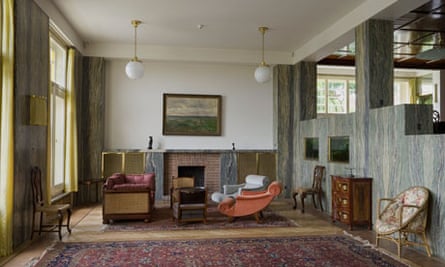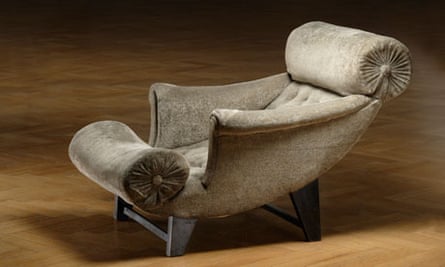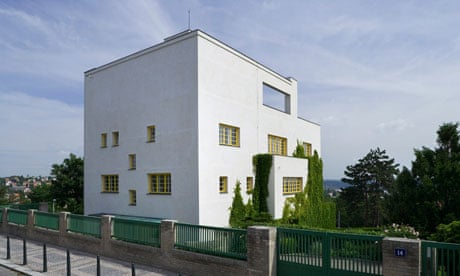"The naked woman," said the architect Adolf Loos, "is unattractive to man." It is one of the more striking statements in the history of architectural writing, and one that may not seem to have much to do with architecture, but it is part of a theory that has done much to shape the buildings of the past 100 years. If you have eaten in a restaurant or visited a hotel describing itself as "minimalist", or ever been struck by the lack of ornament on any modernist building, you will have witnessed the after-effects of this strange thought. According to a 1930s critic: "There lives not one single architect who does not carry within himself a bit of Loos."
Women, argued Loos, have to dress and ornament themselves to appeal to "man's sickly sensuality". They have to wear impractical things such as long skirts that stress their decorative role. It would be much better if both men and women wore plain, well-made clothes like the English suits that he especially liked. Ornament, he famously said, is linked to degeneracy and crime and should be removed from objects of daily use: not just clothes, but furniture and buildings.
Loos is usually described as Austrian, but he grew up in the town of Brno, then part of the Hapsburg empire, now in the Czech Republic. Some of his best works are in that country, in Brno, Prague and Plzen. This week, an exhibition opens at the Royal Institute of British Architects that, originating in Prague, seeks to reclaim Loos for his homeland. It should also, distributed across several floors of Riba's headquarters, be a good introduction to the work of this astonishing man.

It will show the houses and apartments that Loos designed in the 1920s for prosperous bourgeoisie of a country, Czechoslovakia, minted after the Great War by the Treaty of Versailles. He built for a paediatrician, a manufacturer of screws and another of wire, a chemist serving the brewing industry and the hugely successful building contractor František Müller. These were people keen to distance themselves from the past, but also to embrace high culture, and their homes tended to be furnished with pianos and art.
The exteriors of the houses are as plain as Loos said they should be. The house he built for Müller, on a steep slope facing towards Prague Castle, is startlingly white and cubic. Villa Müller's interiors, however, are far from being puritanical boxes. They are lush with oak, flaming mahogany, poplar and elm, and marbles with evocative names: cipollino, with layered patterns like the inside of an onion, and fantastico, with dazzling patterns of black on white. He would use yellow-gold silk for curtains and lampshades and, when it suited, the newest materials of his time, with their own exotic brand names: Xylonite, linoleum, Salubra wallpaper and Duco automative paint that gave the finish of a new car.
He loved mirrors, using them to multiply rooms and dissolve their boundaries, and played games with the veining of marbles. In one convulsive music room, as in a gestalt test, you can read monsters and pudenda into the symmetrical patterns of matched fantastico panels. His shapes are severe, almost all straight-lined and right-angled, but they are full of constrained sensuality. Economy was not the purpose – one of his assistants said that you could build "a very nice detached house" for the cost of one of his rooms. These rich rooms are in fact consistent with Loos's theories of ornament, as they use the inherent patterns of natural materials rather than decoration contrived by man.
He believed that the materials of a room should match its use and mood, with marble in more public places and wood in more intimate rooms, or pale maple in a woman's dressing room and oak in a man's. The dimensions, including height, should also be varied to suit each room, with the result that his houses became three-dimensional jigsaws of interlocking spaces, with many floor and ceiling levels, connected by short flights of steps and crisscrossed by views from one to the other.
Loos was born in 1870 and died in 1933, lived in Vienna at the time of Freud, and makes an easy subject for amateur analysis. His father was a stonemason and his happy early memories of playing in his workshop were cut short at the age of nine when his father died. His mother was strict and he escaped her to join the army as early as possible, only to contract syphilis. She then cut him off, in return for paying for his fare for his three-year trip to the United States.

He married three times, had a long-term mistress, and towards the end of his life he was accused of paedophilia. He had a particular penchant for actresses and dancers. As described in a new book by Anne Anlin Cheng, Second Skin (Oxford University Press), he was fascinated by Josephine Baker. On the basis of a slight acquaintance, he volunteered to design her a house, never built, whose main features were a glass-walled swimming pool surrounded by corridors for viewing her body at exercise, and an exterior in vibrant black-and-white stripes which may have represented his wish to mingle his European restraint with her African-American energy.
He was, in other words, a sensualist, of a possibly twisted kind. His houses, with their blank, mask-like outsides and their intricate, lush-but-disciplined interiors, make perfect emblems of his well-dressed outer self and his complex inner self. Both buildings and writings express a singular, tortured personality, with strange views on desire, yet had a general influence. Architects such as Mies van der Rohe and Le Corbusier learned plainness and controlled luxury from him ("Whatever is good in Le Corbusier's work, he learned from Loos," said Loos, half-ironically.) Mies and Corb were then the dominant influences on architecture for two generations.
His interiors are inward-looking, mesmerising, sometimes a little creepy. There is an air of fragility or tragedy about them, reinforced by later events. His many Jewish clients were forced out of their marbled nests into exile or camps. In 1945, the commanding officer of the local Wehrmacht shot himself in the flat with the convulsive music room, which had been appropriated as headquarters. Old Müller was dispossessed of his fortune by the postwar Communist regime, but allowed to stay on in the house, in whose boiler room he would eventually be found dead; he had operated the equipment wrongly, whether accidentally or on purpose, and poisoned himself with fumes.
Müller's wife, Milada Müllerová, stayed on, lodged in the recesses of the house, and fought with the authorities to stop them wrecking it. Thanks to her, it survived and is now restored, opened to the public, and one of the more compelling of the many compelling sights of Prague.

Comments (…)
Sign in or create your Guardian account to join the discussion